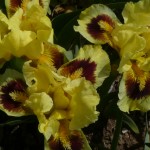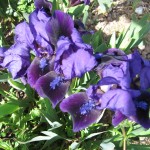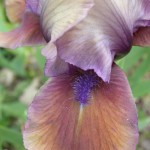Article published in The Garden April 2009
The genus iris is one of the most diverse and popular garden plants with flower shapes and colours almost as variable as their habitats. Iris were named after the Greek goddess Iris, the personification of the rainbow, in recognition of their rainbow hued flowers. Iris species are found throughout the Northern temperate latitudes, growing in conditions as diverse as high mountains pastures to hot Greek hillsides. This means that their cultural requirements are equally diverse, some preferring a cool water’s edge location whereas others require a hot dry situation. The bearded iris fall into the latter group. They have been cultivated since Classical times and depictions of them have appeared in literature and painting for more than 2 centuries. They are pictured in the palace at Knossos on Crete and the French heraldic device, Fleur-de-Lis, was an iris not a lily.
Iris germanica, the common flag or bearded iris, with its fat, surface creeping rhizomes and broad fans of deciduous leaves has been in cultivation for many centuries and has spread all around the word from its Iberian home. I have seen purple flag iris flowering in old oil drums outside a stone house high in Tibet and in gardens on the island of Chiloe off the coast of Southern Chile . There can hardly be a garden in UK without at least one representative of this group, whether it is the classic old purple flag or one of the spectacular modern hybrids with their amazing colour combinations.
Iris breeding took off in the late 19thC and by the early part of the 20thC whole beds were devoted to them. Unlike the simple species modern hybrids have an improved elegance of form, with multiple buds to a stem and beautifully proportioned flowers. The standards are large and upright while the falls are full and flaring but it is their marvelous range of colours that really sets them aside. No visitor to the Chelsea Flower Show can fail to marvel at the spectacular colour combinations displayed on the specialist iris exhibits.
Unfortunately, however seductive their flowers may be, TBI are not quite so easy to integrate into our modern style of gardening. They all need a well drained, rather poor soil and a situation where the sun will fall directly on the rhizome for most of the time if they are to flower well. They became a popular choice for narrow beds under a sunny wall which could be devoted to them. However their all too brief flowering period, and the hard work involved in the annual division of the rhizomes has meant that they are perhaps not as popular as they once were and the classic iris bed is a disappearing feature of our gardens.
Bearded Iris are useful to fill that awkward gap in flowering after the tulips fade and before the majority of the herbaceous perennials start but successful integration into a mixed border is difficult. Here the soil is more fertile than they truly like and any competition or shade from neighbouring plants curtails their flowering. Although their flowers are tall they need to be grown at the front of the border to maximize the sun on their rhizomes and it is therefore not possible to hide the rather large holes left at the edge of the border when they finish flowering.
However their dwarf cousins are much more versatile and distinctly underrated as garden plants. They have an equally long and complex history and are the result of crossing naturally dwarf species such as I. pumila (eg I.pumila ‘Atroviolacea’), with the modern tall bearded iris. Breeders divide them into 2 groups depending upon their height. The Miniature Dwarf Bearded (MDB) are 10 – 20cm tall whereas the largest group, the Standard Dwarf Bearded (SDB) are between 21 – 40cm tall. This is an entirely arbitrary classification and there is no difference in performance between the 2 groups.
The first hybrids had clear, single colours such as blue, purple or yellow eg ‘Stockholm’, ‘Mary McIlroy’*, ‘Zero’* and ‘Open Sky’, their beauty being in their dwarf stature but then gradually patterns, first as veins, known as plicates eg ‘Dunlin’ and then stronger contrasting marks appeared eg ‘Meadow Court’. Finally the colours merged rather like an untidy artist’s palette where all the colours blend into each other often in a dramatic manner eg ‘Quark’ , ‘Peach Eyes’ etc
Although they are dainty and rather delicate in appearance they are fully hardy with a good balance between leaf and flower, the flowers being 2-3” diameter, the best having well rounded, upright standards and falls that are held horizontally, not curving under, so that the patterns are visible; especially important as they are to be viewed from above. They flower for about 1 month in late spring (April-May) just before the TBI. Most have only 1-2 flowers on a single stem but each established plant can be literally smothered in flowers. There are some so-called Remontant forms but I have yet to find one that is truly repeat flowering. There is just an occasional late summer flower. A truly remontant iris with good flowers may come in the future.
All are easy to grow provided a few simple rules are followed. They are shallow rooting and should be planted in a sunny, well-drained position, preferably in poorish soil with the rhizome on the surface and the roots extending downwards. Care must be taken not to allow neighbouring plants, or weeds, to encroach and smother the rhizomes. Congested clumps should be divided in late summer. The old central rhizomes should be discarded and the side ones replanted. Cut the leaves back by 50% and firm the roots well.
If you should have one, they are perfect for planting in front of TBI in a dedicated iris bed where they will flower first. Alternatively they are particularly attractive under a sunny wall, or against the house with other sun lovers such as Iris unguicularis, eucomis, nerine etc., where their fans of leaves provide a good foil for the other plants and where they fill the gap in flowering between I.unguicularis of winter and the late summer/autumn flowering eucomis & nerine. They are also very effective in the narrow beds that are often found edging the path leading to the front door, where they associate well with other low growing plants, especially those with silver foliage or Helianthemums. Smaller tulips are other good companions as they like similar dry sunny positions. [example the walled garden at Wisley].
Their dwarf stature makes them ideal for a sunny herbaceous border where they make a good edging plant. Although, like their tall cousins their rhizomes must be left exposed, they are much smaller and therefore their leaves are closer together and they make rather attractive clumps of foliage along the front edge. As DBIs are individually small it is advisable to plant at least 3 or 5 rhizomes initially to form a reasonable sized patch. Single plants in a border are easily swamped. Take care to keep any mulch away from the rhizomes.
Click here to see our collection of dwarf bearded iris
For tall bearded iris contact:
Seagate Iris
Kelways of Langport
The RHS garden at Wisley has excellent trials of all types of iris.




